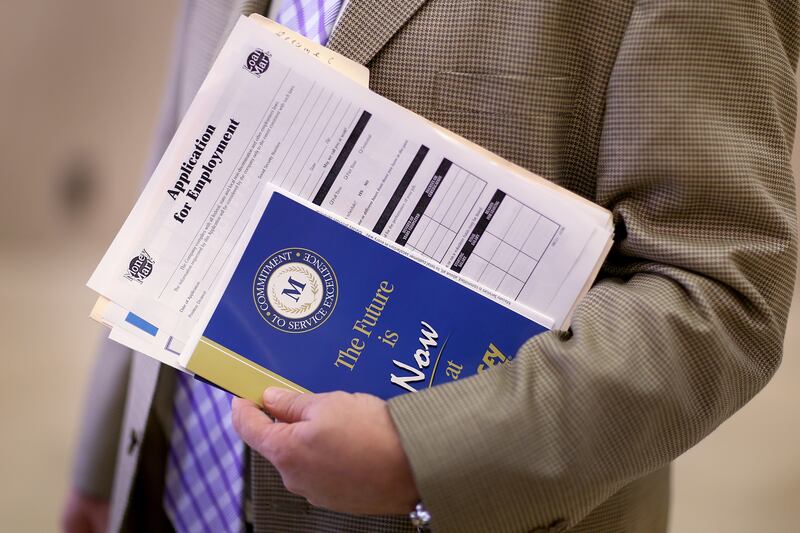It’s been a bad 36 hours or so for American economic declinists. Twitter’s initial public offering demonstrated the ability of the American entrepreneurial engine to create an entity worth $20 billion essentially from scratch. Fannie Mae and Freddie Mac, the two mortgage-giant basket cases that were the ne plus ultra of the 2008 financial debacle, requiring an injection of $180 billion putatively irretrievable taxpayer funds, said Thursday they’d return to Treasury $8.6 billion and $30.4 billion, respectively, essentially making the taxpayers whole on the bailout, when they reported (PDF) quarterly profits (PDF). Meanwhile, it turns out that the economy chugged ahead in the summer. The Commerce Department reported Thursday that the economy grew at a 2.8 percent rate in the third quarter. On Friday, the same agency reported that personal income and savings both rose at impressive rates in September.

But the most impressive report was Friday morning’s jobs report, which gave us one of the first reads on how the economy preformed in October, a month in which the government shut down and a threat of default sandbagged demand and threw sand into the economic gears. And still it turned out the economy performed pretty well. In October, according to the Bureau of Labor Statistics, the U.S. added an impressive 204,000 payroll jobs.
The takeaway from this run of data is that the government is losing its ability to inflict damage on the U.S. economy. Yes, falling government spending and higher taxes are removing cash from the economy. Yes, the stupid sequester is unnecessarily throwing people out of work and tamping down demand. And, yes, the rolling Republican temper tantrums have acted as a malign force. But while these factors function as a powerful drag, they are not sufficiently powerful to overcome the momentum of the private sector, and of the recovering state and local government sectors.
Let’s look at the data. In August and September, private wages and salaries rose $34.8 billion and $18.8 billion, respectively. In the same months, government wages and salaries rose $2.3 billion and $8.8 billion, respectively. “Government wages were reduced by $7.3 billion in August and $7.7 billion in July due to furloughs that affected several federal government agencies,” the jobs report says. Translation: workers would have had much more money to spend if not for the furloughs, but the underlying trend of salary growth is intact—in both the private and public sectors.
Let’s look at this another way. In every quarterly GDP report, the Commerce Department describes how much each sector contributed to—or detracted from—overall growth. (See Page 6 of this release (PDF).) In the third quarter, as has been typical, the federal government, by reducing spending and investment, sapped the growth rate by 13 basis point, or .13 percent. That’s bad, but it represents an improvement from the first half of the year, when government spending cuts took a much larger bite out of growth. At the same time, however, state and local governments, whose finances have been on the mend, once again are contributing to growth. In the third quarter, their spending and investment added 17 basis points, or .17 percent, to the growth rate, which more than compensated for the federal decline.
As for employment, I noted early last month the many ways in which the shutdown could harm the economy and the jobs market. And the jobs report shows it definitely had an impact. In October, the labor force participation rate fell and the unemployment rate bumped up, in part because some 480,000 furloughed government employees were counted as “unemployed.” And yet the private sector largely shrugged off the pain. It turns out that the labor market was a little stronger than previously thought going into October. Each month when BLS reports results, it looks backs and revises the prior two months. On Friday, the August figure was revised from 193,000 to 238,000, while the September number was revised from 148,000 to 163,000. Put another way, BLS now says 60,000 more people were working at payroll jobs at the beginning of October than we previously thought. Add in the 204,000 jobs created in October, and the economy has added 635,000 payroll positions in the past three months. That’s solid.
To be sure, the government continued to exercise a malign influence on employment in October. I’ve long dubbed this expansion the “conservative recovery,” because the private sector has steadily added jobs since early 2010 while the public sector has steadily cut them, which doesn’t usually happen in an expansion. Since May 2010, the government sector has cut 1.12 million positions. But the government job-letting is coming to an end. In October, as might be expected, the federal government reduced its payrolls by 12,000. In the past year, the federal government has cut direct employment by 94,000, or 3.3 percent. But once again, state and local governments are doing better. In October, state and local government added a combined 4,000 jobs. In the past year, they’ve added a combined 68,000 positions. Modestly rising activity at the state and local level is counteracting, and almost entirely offsetting, the austerity-inducing actions of the federal government.
Of course, when you look through the jobs report, there’s plenty to be gloomy about. We’re still 1.5 million jobs short of the peak employment level of January 2008. Wages are rising at a slow rate, up about 2.2 percent in the past 12 months, and too many people are unemployed or underemployed. The U-6 measure of unemployment, which takes into account frustrated workers and people who are working part-time but would prefer to be working full-time, stood at 13.8 percent in October.
There have been lots of calls for government to do more to help the labor market and the economy heal: boosting the minimum wage, undoing the sequester, providing new funds for infrastructure investment. It would be great if Republicans could be coaxed to sign on to one or more of these efforts. Of course they won’t. Meanwhile, the private sector—and state and local governments—are getting on with their business and plowing ahead. Perhaps the best that can be hoped for is that the congressional GOP will stop staging the sorts of dramas that hamstring growth, scare consumers, and make it difficult for businesses to do their thing.




